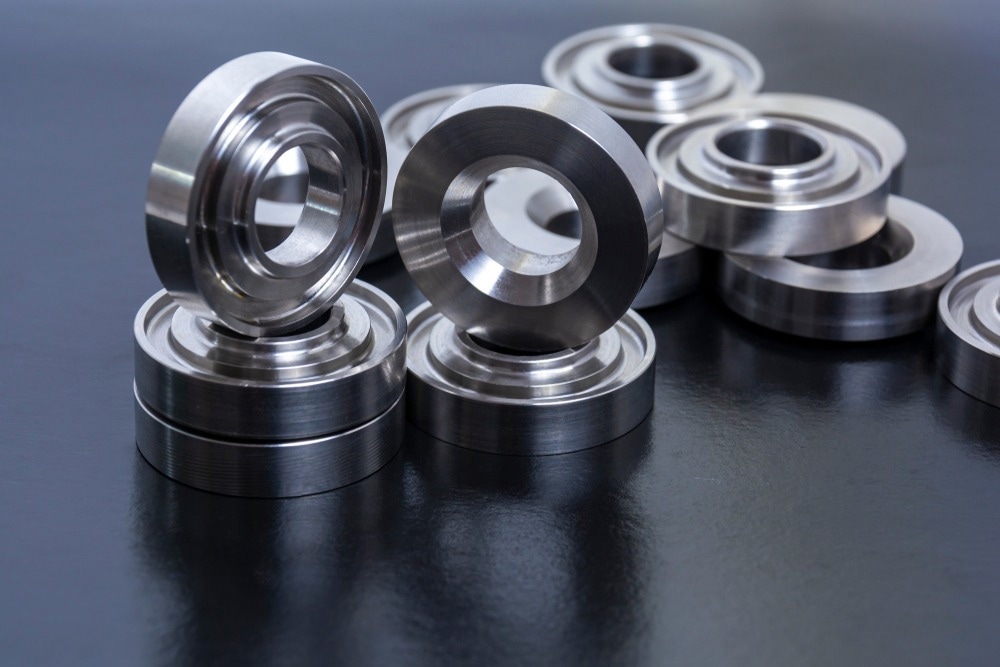 By Taha KhanReviewed by Lexie CornerMay 22 2024
By Taha KhanReviewed by Lexie CornerMay 22 2024Aluminum alloys find applications in various industries, offering lightness, corrosion resistance, and a high strength-to-weight ratio. Among them, AA2024 stands out, particularly in high-performance applications.1

Image Credit: GaViAl/Shutterstock.com
What is AA2024?
AA2024 is a heat-treatable aluminum-copper alloy that comprises aluminum, copper, magnesium, silicon, iron, and manganese.
It provides an excellent strength-to-weight ratio, high tensile strength, and good fatigue resistance, making it a viable choice for high-stress and cyclic loading applications. For instance, it is used in structural components in the aerospace and automotive industries.
AA2024: Microstructure
The microstructure of AA2024 significantly impacts its mechanical properties. To optimize its performance for specific applications, engineers often manipulate these microscopic features.1, 2
For instance, during casting, the cooling and solidification of the molten alloy influence the grain size and distribution of intermetallic compounds. Rapid solidification techniques, like spray casting, can generate finer grains, leading to improved strength.2
However, cast structures often exhibit an uneven distribution of alloying elements. Homogenization heat treatment eliminates these variations by heating the alloy to a high temperature for a specific duration. This promotes the diffusion of elements, resulting in a more uniform microstructure. 2-4
Similarly, hot-working processing conditions like extrusion and rolling deform the alloy at elevated temperatures. This refines the grain structure, improving its strength and workability. The extent of deformation and temperature control the final grain size and texture.2
Extrusion and Heat Treatment to Improve Microstructure and Mechanical Properties
A recent study explored the use of heat treatment and reverse isothermal extrusion to enhance the properties of AA2024. They found that extrusion significantly refined the grain structure, reduced coarse eutectic microstructures, and introduced S-phase precipitates, leading to substantial improvements in tensile strength and elongation. 2
EBSD analysis revealed a copper rolling texture along the extrusion direction, which contributed to alloy strengthening. Annealing further enhanced alloy properties by promoting recrystallization and reducing dislocation density. The study shows the efficacy of extrusion and annealing treatments in improving the mechanical properties of 2024 aluminum alloy.2
Impact of Natural Re-aging on Microstructural Evolution
In another study, researchers explored the impact of short-term natural re-aging following T351 temper on the microstructural evolution and mechanical properties of AA2024.
Grain growth was observed in the natural re-aged sample, with Al7Cu2Fe particles mainly located within the alpha grains. X-Ray diffraction (XRD) analysis revealed a shift in peak positions, indicating the formation of various precipitates during re-aging.3
The study showed a high precipitation rate during natural aging, leading to increased hardness and mechanical strength over time. The natural, re-aged alloy exhibited improved tensile strength compared to the as-received sample, attributed to accelerated precipitation (facilitated by Al7Cu2Fe particles).
The study also highlighted the postponement of Portevin-Le Chatelier instability and increased work hardening rate with longer re-aging times. This research highlights the potential of natural re-aging as a technique to enhance the mechanical properties of AA2024.3
Mechanics and Applications
Finer grain size and well-distributed precipitates enhance the strength of AA2024 by impeding dislocation movement to limit deformation. However, there is a trade-off between strength and ductility, as they are often inversely proportional.
Optimizing the microstructure can enhance the fatigue life of AA2024 components, as the size and distribution of precipitates also influence fatigue crack initiation and propagation.3, 5
These microstructure-dependent mechanical properties (strength, ductility, and fatigue life) translate into a wide range of applications for AA2024. For instance, the high strength-to-weight ratio makes AA2024 ideal for aerospace structures like aircraft wings and fuselage components.6
Similarly, in the automotive industry, AA2024 is used in high-performance components like wheels and engine parts, as well as in machined parts like gears and pistons.
Aeronautical Application of AA2024
A 2023 study explored the aeronautical applications of AA2024, focusing on the impact of various heat treatments on the electrochemical corrosion behavior of AA2024 and AA2055 alloys in different electrolytes.7
The study utilized electrochemical noise techniques, analyzing both time and frequency domains. Results indicated superior mechanical properties of AA2055 alloy over AA2024, particularly in Vickers hardness.7
Electrochemical noise resistance was notably higher in AA2055 alloys, especially under T6 and T8 heat treatments. Microstructural and mechanical analyses revealed insights into the alloys' corrosion performance and hardness variations under different treatments.
These findings will help researchers optimize corrosion resistance while enhancing mechanical properties in aeronautical aluminum alloys, which are crucial for ensuring aircraft longevity and performance.7
Future Advancements of AA024
In the future, techniques like electron microscopy and atom probe tomography can be coupled with advanced modeling tools. This approach could facilitate the prediction and optimization of microstructure for tailored properties.8
Additive manufacturing (AM) techniques like 3D printing can also provide a platform for fabricating complex AA2024 components with tailored microstructures. For instance, precise control offered by the laser melting process during AM can lead to novel microstructures and superior mechanical properties.9
Similarly, nanoparticle incorporation into AA2024 could enhance its strength and other mechanical properties. This is because nanoparticles can act as nucleation sites for precipitation hardening, leading to finer and more uniformly distributed precipitates.10
These advancements will enable AA2024 to be utilized in novel applications, including in the components of electric vehicles, next-generation aerospace structures, and even biocompatible implants.
More from AZoM: The Global Lithium Battery Market: Growth and Trends
References and Further Reading
- El-Shorbagy, RM., El-Baradie, ZM., Abdel-Aziz, AI. (2023). Microstructure and Mechanical Properties of 2024 Aluminum Alloy with and Without Rare-Earth and Thermomechanical Treatment After Multi-pass Stir Friction Processing. International Journal of Metalcasting. doi.org/10.1007/s40962-023-01191-7
- Li, Q., Zhang, X., Wang, L., Qiao, J. (2022). The effect of extrusion and heat treatment on the microstructure and tensile properties of 2024 aluminum alloy. Materials. doi.org/10.3390%2Fma15217566
- Haghdadi, F., Jamaati, R., Hosseinipour, SJ. (2024). Evading the strength-ductility trade-off dilemma in AA2024 alloy by short-term natural re-aging after T351 temper. Heliyon. doi.org/10.1016%2Fj.heliyon.2024.e27257
- Kassner, ME., Li, X., McQueen, HJ. (1993). The effect of homogenization and precipitation treatments on the extrudability and ambient-temperature mechanical properties of aluminum alloy AA2024. Materials Science and Engineering. doi.org/10.1016/0921-5093(93)90593-4
- Hughes, AE., Parvizi, R., Forsyth, M. (2015). Microstructure and corrosion of AA2024. Corrosion Reviews. doi.org/10.1515/corrrev-2014-0039
- Halkaci, HS., Turkoz, M., Yiğit, O. (2012). Effects of heat treatment conditions on the mechanical properties of AA 2024 alloy. Applied Mechanics and Materials. doi.org/10.4028/www.scientific.net/AMM.217-219.1225
- Rivera-Cerezo, H., et al. (2023). Effect of heat treatment on the electrochemical behavior of AA2055 and AA2024 alloys for aeronautical applications. Metals. https://doi.org/10.3390/met13020429
- Parvizi, R., Marceau, RK., Hughes, AE., Tan, MY., Forsyth, M. (2014). Atom probe tomography study of the nanoscale heterostructure around an Al20Mn3Cu2 dispersoid in aluminum alloy 2024. Langmuir. doi.org/10.1021/la503418u
- Zhu, X., Zhu, Z., Liu, T., Liao, W., Du, Y., Wei, H. (2023). Crack-free and high-strength AA2024 alloy obtained by additive manufacturing with controlled columnar-equiaxed-transition. Journal of Materials Science & Technology. doi.org/10.1016/j.jmst.2023.01.012
- Mahan, HM., Konovalov, SV., Panchenko, I. (2023). Effect of heat treatment on the mechanical properties of the aluminium alloys AA2024 with nanoparticles. International Journal of Applied Science and Engineering. doi.org/10.6703/IJASE.202306_20(2).011
Disclaimer: The views expressed here are those of the author expressed in their private capacity and do not necessarily represent the views of AZoM.com Limited T/A AZoNetwork the owner and operator of this website. This disclaimer forms part of the Terms and conditions of use of this website.